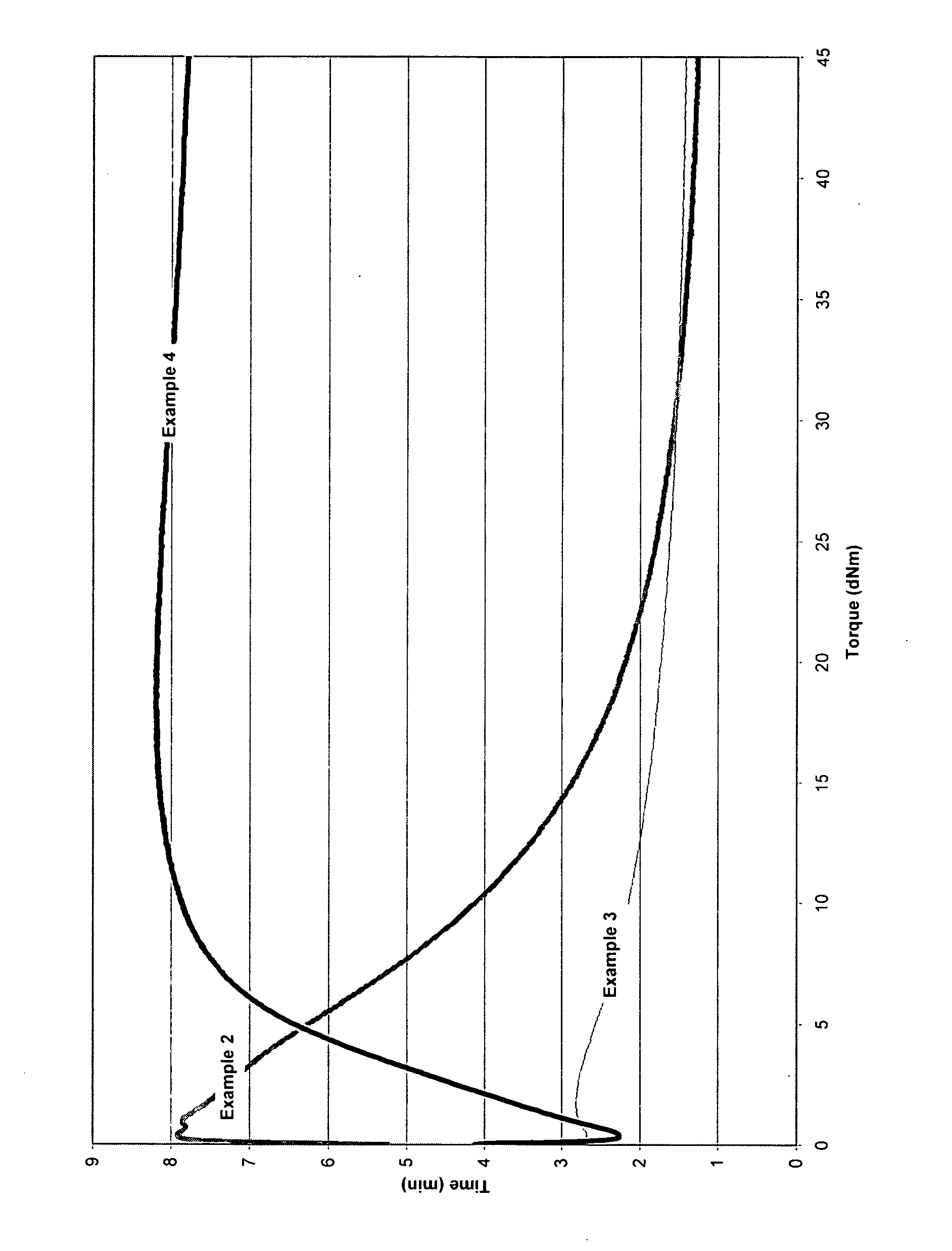Peroxide curable butyl formulations
- Summary
- Abstract
- Description
- Claims
- Application Information
AI Technical Summary
Benefits of technology
Problems solved by technology
Method used
Image
Examples
example 1
[0062] The terpolymer containing isobutylene, isoprene and para-methylstyrene (PMS) was prepared in a pilot plant with the use of a 12 L batch reactor.
[0063] To 5586 g of methyl chloride was added 1344 g of isobutylene, 52.8 g of isoprene and 305 g of PMS. The reactor contents were cooled to −95° C. at which point an AlCl3—CH3Cl catalyst solution was introduced. The rubber which was recovered from the reactor was mill dried and submitted for compositional analysis (1H NMR). The resulting polymer was found to contain 82.8 mol % isobutylene, 15.7 mol % PMS, and 1.49 mol % isoprene and was gel-free.
General Mixing Recipe
[0064] Unless otherwise stated, all of the compounds (2, 3 and 4) studied were composed of:
Polymer:100 phrCarbon black (IRB #7; N330): 50 phrPeroxide (DI-CUP 40 C): 4 phr
[0065] Mixing was achieved with the use of a Brabender internal mixer (capacity ca. 75 g) with a starting temperature of 60° C. and a mixing speed of 50 rpm according to the following sequence:
0....
example 2
Comparative
[0067] This compound was based on a commercial polyisobutylene rubber (VISTANEX, MML-100) from Exxon according to the recipe presented above. As can be seen from FIG. 1, no cure reactivity was evident in this system. In fact, the MDR trace reveals significant degradation. This observation is consistent with what is known about the free-radical degradation of PIB.
examples 3
Comparative
[0068] The following comparative example explores the peroxide cure of a random copolymer of a C4 to C7 isomonolefin with up to 20 wt. % of para-alkylstyrene, e.g., copolymers of isobutylene and para-methylstyrene as defined in U.S. Pat. No. 5,578,682. The material was prepared with the use of a 5 L batch reactor.
[0069] To 1980 mL of methyl chloride was added 220 mL of isobutylene and 12 mL of para-methylstyrene. The reactor contents were cooled to −95° C. at which point an AlCl3—CH3Cl catalyst solution was introduced. The rubber which was recovered from the reactor was mill dried and submitted for compositional (1H NMR) and molecular weight (GPC) analysis. The resulting polymer was found to contain 97 mol % isobutylene, 3 mol % of paramethylstyrene, a weight average molecular weight of 450 kg·mol−1 and a number average molecular weight of 125 kg·mol−1.
[0070] The compound studied was composed of:
Polymer:100 phrCarbon black (IRB #7; N330): 50 phrPeroxide (DI-CUP 40 C)...
PUM
 Login to View More
Login to View More Abstract
Description
Claims
Application Information
 Login to View More
Login to View More - R&D Engineer
- R&D Manager
- IP Professional
- Industry Leading Data Capabilities
- Powerful AI technology
- Patent DNA Extraction
Browse by: Latest US Patents, China's latest patents, Technical Efficacy Thesaurus, Application Domain, Technology Topic, Popular Technical Reports.
© 2024 PatSnap. All rights reserved.Legal|Privacy policy|Modern Slavery Act Transparency Statement|Sitemap|About US| Contact US: help@patsnap.com








